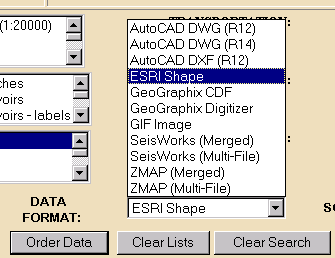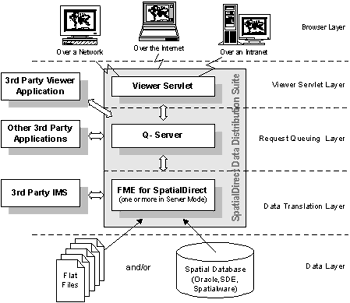PanCanadian is one of Canada's largest producers and marketers of crude oil, natural gas, and natural gas liquids.Among the leading difficulties PanCanadian faced was the fact that their data was kept in as many as eight different mapping and CAD file formats.And many of the end-users they had in mind used none of these! If a solution existed, it would have to remove all "data translation" burdens from their end-users.SAFE, a long-time partner of PanCanadian, had built its reputation on translating GIS data among a wide variety of formats.What could be done?
SAFE and PanCanadian tackled the problem, and the result of their efforts has empowered PanCanadian users, while at the same time giving rise to a new product line at SAFE, the SpatialDirect Data Distribution Suite.
The SpatialDirect suite is a set of products which:
- asks the non-technical user, in his ubiquitous browser, what data (which layers, over what extent) he'd like to use; and in what format
- passes this request to a brokering layer which manages server load-balancing, and
- directs a server-based version of FME (SAFE's data translation software) to translate and deliver the required data in the format specified by the end-user.

"Ordering" data with SpatialDirect
Moments later, you are in ArcView, happily mapping away.To a new user, this seems merely
sensible.To those of us inured to thankless hours of "format" issues, the idea that data
in dozens of formats can be readily and nearly instantaneously delivered in an immediately-usable form seems more like a miracle.
Among the options from which end-users can choose is "coordinate system:" up to 800 choices are built into the product.
Interestingly, many of PanCanadian's end-users aren't using mapping software at all; they choose the "GIF" image option and stick the map directly into a software package such as Corel Draw! In fact, using SAFE's Viewer Servlet or another company's internet map server software, many users will never "order" the maps for download, but will carry out their work directly within the SpatialDirect environment.
SpatialDirect is styled a "suite" because it is a three-tiered piece of software, each piece performing a specific function.In a given implementation of SpatialDirect, one or two of these functions might be handled by third-party software.The three software layers are:
- The interface with the end-user.This is browser-based.This function can be fulfilled by SAFE's Viewer Servlet; by a custom built front-end; or by a web-based mapping product such as ESRI's ArcIMS, MapInfo's MapXtreme, or GeoMicro's AltaMap.
- A request queuing layer, handling load balancing among possibly multiple servers, and
- FME (Feature Manipulation Engine), SAFE's data translation core software, in server mode, translating and delivering data

SpatialDirect functional schematic
Click to enlarge
SAFE was founded in 1993, and now employs 17 people.The company has been diligent in
building bridges with most if not all of the GIS community, boasting strong ties with Bentley, ESRI, MapInfo, and Smallworld, among others.SAFE received a
strong boost in 1998 when MapInfo contracted to deliver a subset of functionality from SAFE's single-user stand-along translation product, FME Spatial Data Translator, in every copy of
MapInfo Professional.
SpatialDirect will appeal to Oil & Gas, Telecommunications and Utilities companies.It has also elicited strong interest among municipalities and others who are chartered to "share" their data with the public, but have been stymied by data format-driven logistical difficulties.Several SAFE customers are considering marrying SpatialDirect to an eCommerce front end.
While at first blush the virtue of SpatialDirect will seem to be its removal of barriers between the plethora of GIS and CAD data formats, there is a bigger prize lurking in the background.SpatialDirect will also read and write to Oracle 8i databases.Oracle's customers - 15 million users in the largest corporations around the globe - are a very tempting target.
SAFE expects to release SpatialDirect in October.It will be sold direct, and through SAFE's reseller network.SAFE, and partners such as the Convergent Group (who are working with SAFE in implementing SpatialDirect at the City of Portland, Oregon) will be available to customers to assist in implementation.
 Dale Lutz
Dale Lutz